Manchester United: Cultural Shifts and Strategic Implications Analysis
VerifiedAdded on 2020/12/30
|10
|2981
|406
Report
AI Summary
This report provides a comprehensive analysis of Manchester United's business strategy, examining the club's key stakeholders, including the Glazer Family, media, and sponsors, and evaluating their power and attention using Mendelow's Stakeholder Mapping model. It delves into the significant cultural changes within the club from its PLC transformation in 1991, highlighting shifts in values from a focus on winning to a profit-oriented approach. The report critically assesses the implications of these changes on current and future strategies, considering the impact on stakeholders, brand image, and the club's overall performance. It also discusses the use of Charles Handy's model to understand the club's culture and how these factors influence its strategic direction. The report emphasizes the importance of adapting to the changing environment while considering the expectations of various stakeholders to maintain competitive advantage. The shift towards a global brand and the implications of debt are also discussed.
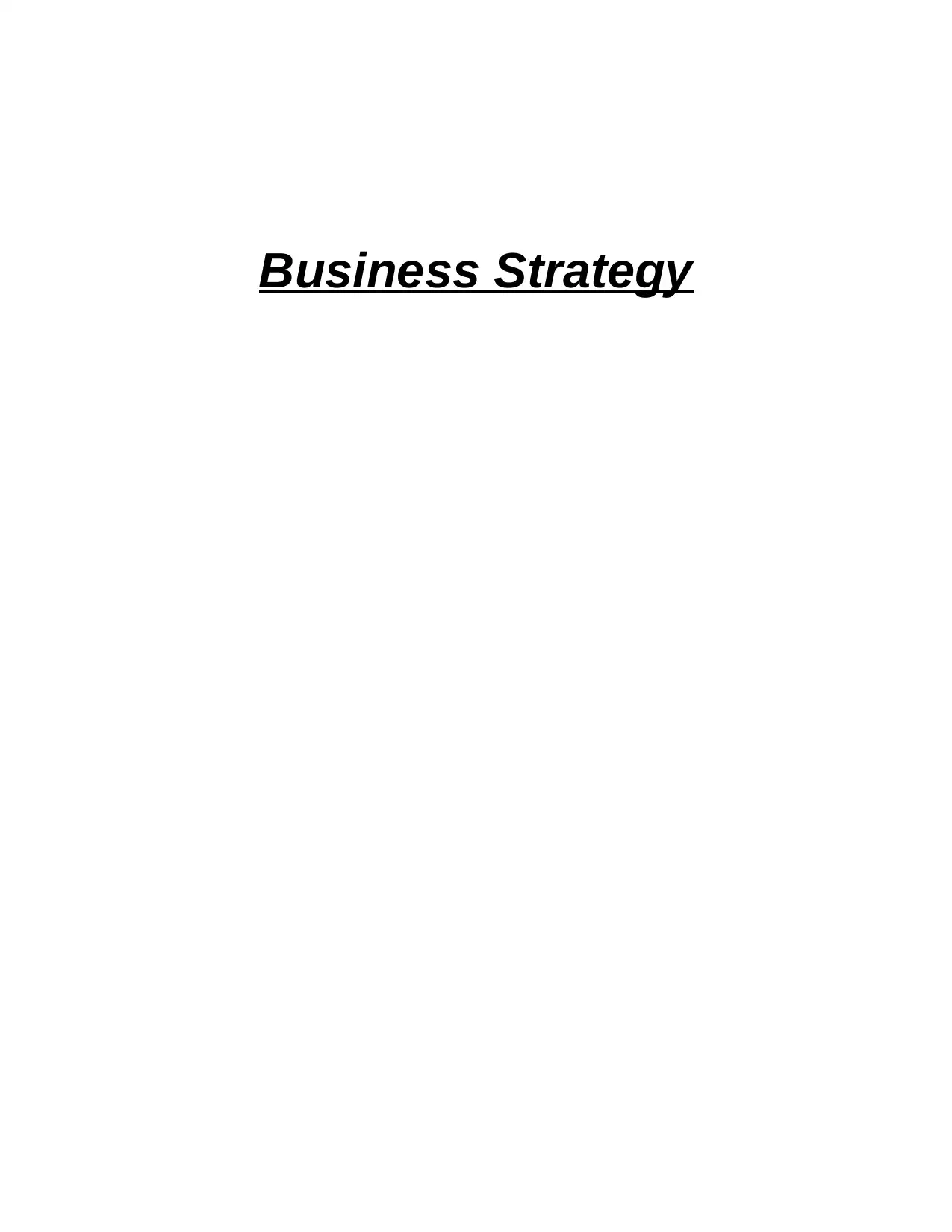
Business Strategy
Paraphrase This Document
Need a fresh take? Get an instant paraphrase of this document with our AI Paraphraser
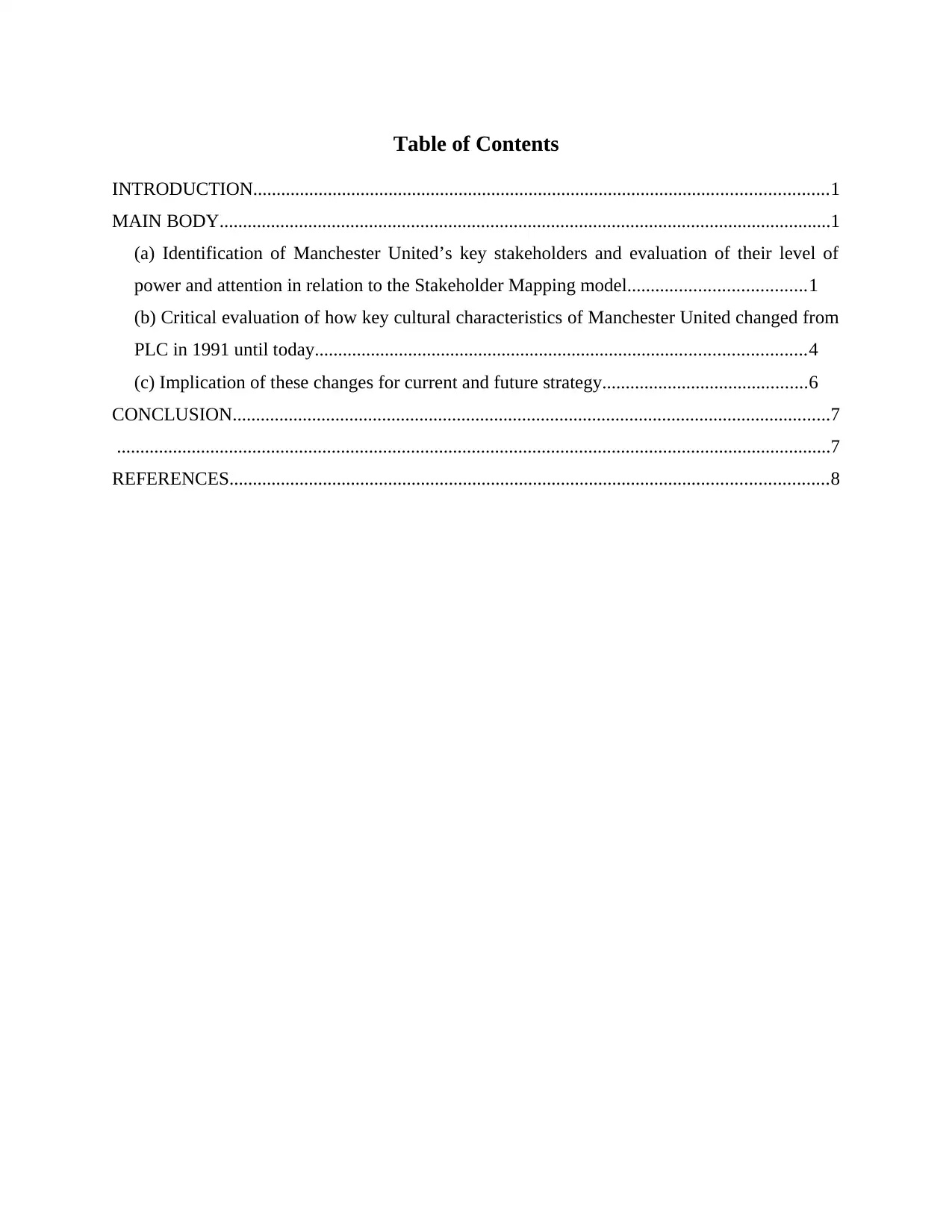
Table of Contents
INTRODUCTION...........................................................................................................................1
MAIN BODY...................................................................................................................................1
(a) Identification of Manchester United’s key stakeholders and evaluation of their level of
power and attention in relation to the Stakeholder Mapping model......................................1
(b) Critical evaluation of how key cultural characteristics of Manchester United changed from
PLC in 1991 until today.........................................................................................................4
(c) Implication of these changes for current and future strategy............................................6
CONCLUSION................................................................................................................................7
.........................................................................................................................................................7
REFERENCES................................................................................................................................8
INTRODUCTION...........................................................................................................................1
MAIN BODY...................................................................................................................................1
(a) Identification of Manchester United’s key stakeholders and evaluation of their level of
power and attention in relation to the Stakeholder Mapping model......................................1
(b) Critical evaluation of how key cultural characteristics of Manchester United changed from
PLC in 1991 until today.........................................................................................................4
(c) Implication of these changes for current and future strategy............................................6
CONCLUSION................................................................................................................................7
.........................................................................................................................................................7
REFERENCES................................................................................................................................8
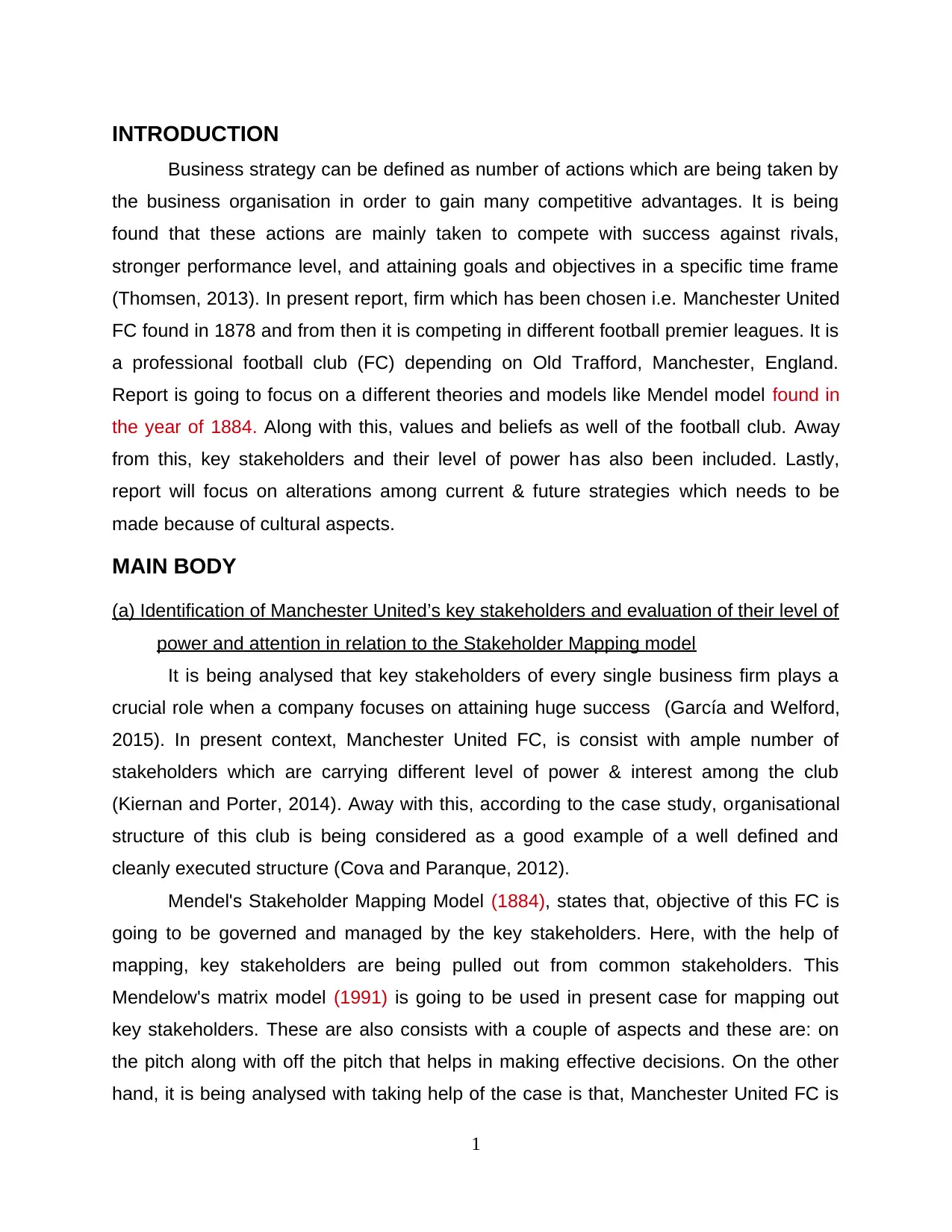
INTRODUCTION
Business strategy can be defined as number of actions which are being taken by
the business organisation in order to gain many competitive advantages. It is being
found that these actions are mainly taken to compete with success against rivals,
stronger performance level, and attaining goals and objectives in a specific time frame
(Thomsen, 2013). In present report, firm which has been chosen i.e. Manchester United
FC found in 1878 and from then it is competing in different football premier leagues. It is
a professional football club (FC) depending on Old Trafford, Manchester, England.
Report is going to focus on a different theories and models like Mendel model found in
the year of 1884. Along with this, values and beliefs as well of the football club. Away
from this, key stakeholders and their level of power has also been included. Lastly,
report will focus on alterations among current & future strategies which needs to be
made because of cultural aspects.
MAIN BODY
(a) Identification of Manchester United’s key stakeholders and evaluation of their level of
power and attention in relation to the Stakeholder Mapping model
It is being analysed that key stakeholders of every single business firm plays a
crucial role when a company focuses on attaining huge success (García and Welford,
2015). In present context, Manchester United FC, is consist with ample number of
stakeholders which are carrying different level of power & interest among the club
(Kiernan and Porter, 2014). Away with this, according to the case study, organisational
structure of this club is being considered as a good example of a well defined and
cleanly executed structure (Cova and Paranque, 2012).
Mendel's Stakeholder Mapping Model (1884), states that, objective of this FC is
going to be governed and managed by the key stakeholders. Here, with the help of
mapping, key stakeholders are being pulled out from common stakeholders. This
Mendelow's matrix model (1991) is going to be used in present case for mapping out
key stakeholders. These are also consists with a couple of aspects and these are: on
the pitch along with off the pitch that helps in making effective decisions. On the other
hand, it is being analysed with taking help of the case is that, Manchester United FC is
1
Business strategy can be defined as number of actions which are being taken by
the business organisation in order to gain many competitive advantages. It is being
found that these actions are mainly taken to compete with success against rivals,
stronger performance level, and attaining goals and objectives in a specific time frame
(Thomsen, 2013). In present report, firm which has been chosen i.e. Manchester United
FC found in 1878 and from then it is competing in different football premier leagues. It is
a professional football club (FC) depending on Old Trafford, Manchester, England.
Report is going to focus on a different theories and models like Mendel model found in
the year of 1884. Along with this, values and beliefs as well of the football club. Away
from this, key stakeholders and their level of power has also been included. Lastly,
report will focus on alterations among current & future strategies which needs to be
made because of cultural aspects.
MAIN BODY
(a) Identification of Manchester United’s key stakeholders and evaluation of their level of
power and attention in relation to the Stakeholder Mapping model
It is being analysed that key stakeholders of every single business firm plays a
crucial role when a company focuses on attaining huge success (García and Welford,
2015). In present context, Manchester United FC, is consist with ample number of
stakeholders which are carrying different level of power & interest among the club
(Kiernan and Porter, 2014). Away with this, according to the case study, organisational
structure of this club is being considered as a good example of a well defined and
cleanly executed structure (Cova and Paranque, 2012).
Mendel's Stakeholder Mapping Model (1884), states that, objective of this FC is
going to be governed and managed by the key stakeholders. Here, with the help of
mapping, key stakeholders are being pulled out from common stakeholders. This
Mendelow's matrix model (1991) is going to be used in present case for mapping out
key stakeholders. These are also consists with a couple of aspects and these are: on
the pitch along with off the pitch that helps in making effective decisions. On the other
hand, it is being analysed with taking help of the case is that, Manchester United FC is
1
⊘ This is a preview!⊘
Do you want full access?
Subscribe today to unlock all pages.

Trusted by 1+ million students worldwide
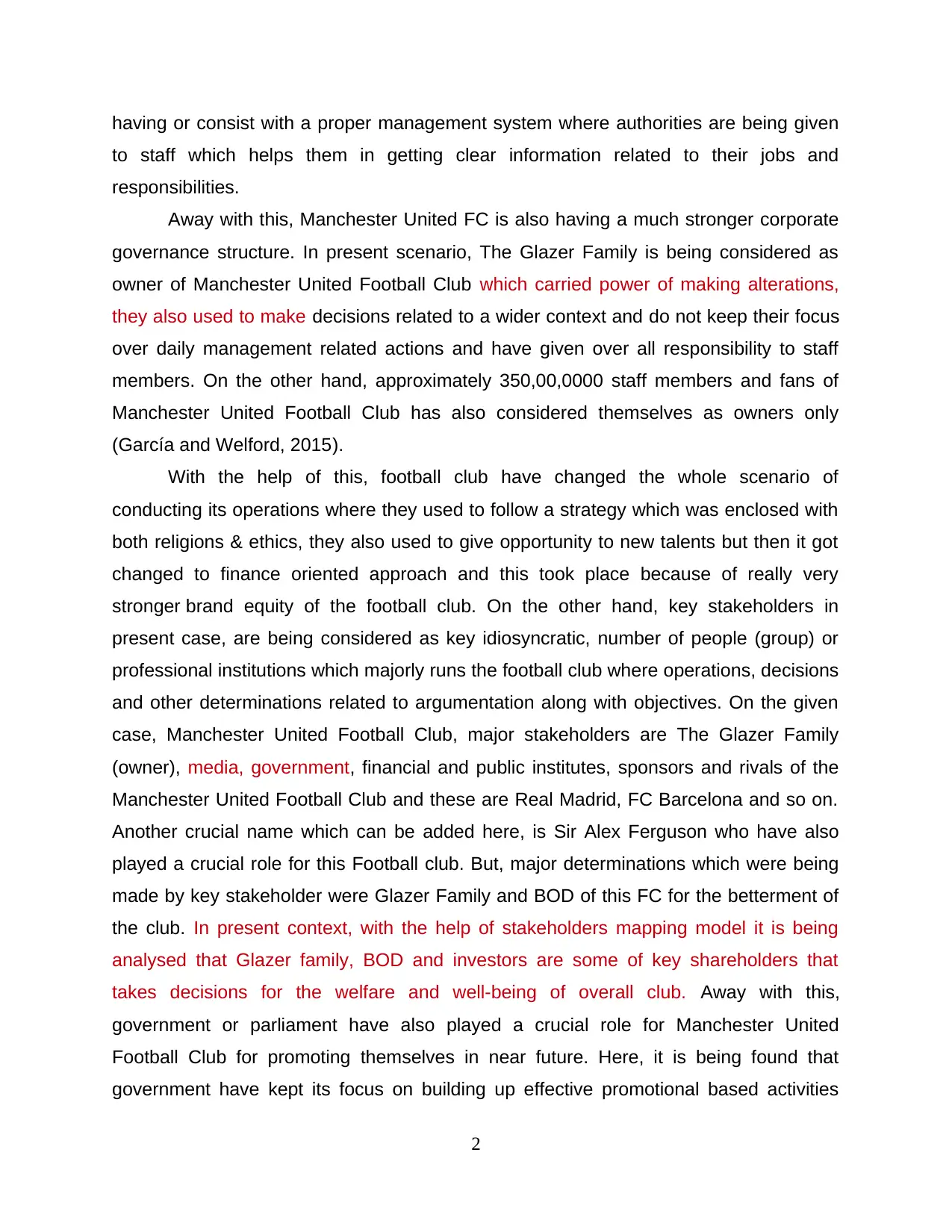
having or consist with a proper management system where authorities are being given
to staff which helps them in getting clear information related to their jobs and
responsibilities.
Away with this, Manchester United FC is also having a much stronger corporate
governance structure. In present scenario, The Glazer Family is being considered as
owner of Manchester United Football Club which carried power of making alterations,
they also used to make decisions related to a wider context and do not keep their focus
over daily management related actions and have given over all responsibility to staff
members. On the other hand, approximately 350,00,0000 staff members and fans of
Manchester United Football Club has also considered themselves as owners only
(García and Welford, 2015).
With the help of this, football club have changed the whole scenario of
conducting its operations where they used to follow a strategy which was enclosed with
both religions & ethics, they also used to give opportunity to new talents but then it got
changed to finance oriented approach and this took place because of really very
stronger brand equity of the football club. On the other hand, key stakeholders in
present case, are being considered as key idiosyncratic, number of people (group) or
professional institutions which majorly runs the football club where operations, decisions
and other determinations related to argumentation along with objectives. On the given
case, Manchester United Football Club, major stakeholders are The Glazer Family
(owner), media, government, financial and public institutes, sponsors and rivals of the
Manchester United Football Club and these are Real Madrid, FC Barcelona and so on.
Another crucial name which can be added here, is Sir Alex Ferguson who have also
played a crucial role for this Football club. But, major determinations which were being
made by key stakeholder were Glazer Family and BOD of this FC for the betterment of
the club. In present context, with the help of stakeholders mapping model it is being
analysed that Glazer family, BOD and investors are some of key shareholders that
takes decisions for the welfare and well-being of overall club. Away with this,
government or parliament have also played a crucial role for Manchester United
Football Club for promoting themselves in near future. Here, it is being found that
government have kept its focus on building up effective promotional based activities
2
to staff which helps them in getting clear information related to their jobs and
responsibilities.
Away with this, Manchester United FC is also having a much stronger corporate
governance structure. In present scenario, The Glazer Family is being considered as
owner of Manchester United Football Club which carried power of making alterations,
they also used to make decisions related to a wider context and do not keep their focus
over daily management related actions and have given over all responsibility to staff
members. On the other hand, approximately 350,00,0000 staff members and fans of
Manchester United Football Club has also considered themselves as owners only
(García and Welford, 2015).
With the help of this, football club have changed the whole scenario of
conducting its operations where they used to follow a strategy which was enclosed with
both religions & ethics, they also used to give opportunity to new talents but then it got
changed to finance oriented approach and this took place because of really very
stronger brand equity of the football club. On the other hand, key stakeholders in
present case, are being considered as key idiosyncratic, number of people (group) or
professional institutions which majorly runs the football club where operations, decisions
and other determinations related to argumentation along with objectives. On the given
case, Manchester United Football Club, major stakeholders are The Glazer Family
(owner), media, government, financial and public institutes, sponsors and rivals of the
Manchester United Football Club and these are Real Madrid, FC Barcelona and so on.
Another crucial name which can be added here, is Sir Alex Ferguson who have also
played a crucial role for this Football club. But, major determinations which were being
made by key stakeholder were Glazer Family and BOD of this FC for the betterment of
the club. In present context, with the help of stakeholders mapping model it is being
analysed that Glazer family, BOD and investors are some of key shareholders that
takes decisions for the welfare and well-being of overall club. Away with this,
government or parliament have also played a crucial role for Manchester United
Football Club for promoting themselves in near future. Here, it is being found that
government have kept its focus on building up effective promotional based activities
2
Paraphrase This Document
Need a fresh take? Get an instant paraphrase of this document with our AI Paraphraser
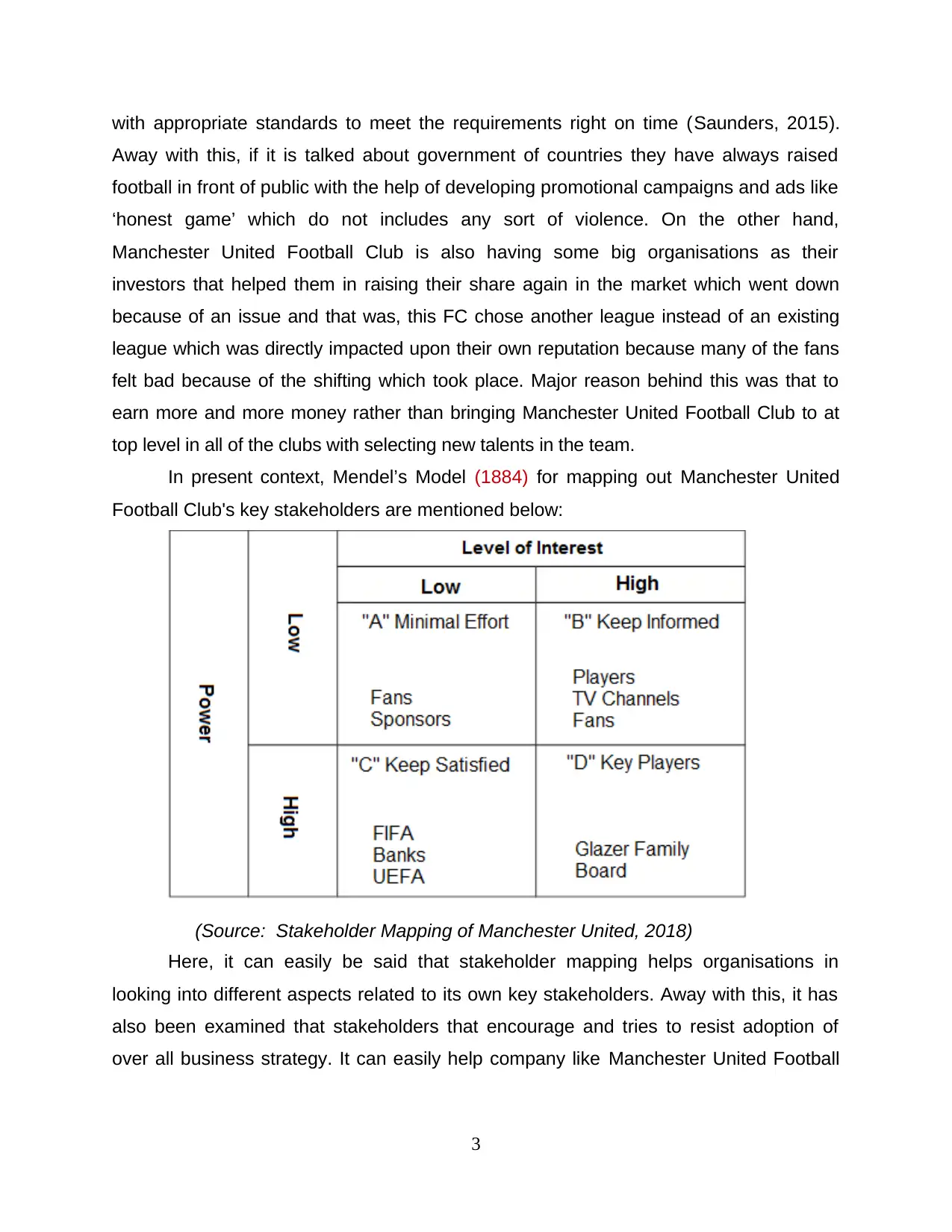
with appropriate standards to meet the requirements right on time (Saunders, 2015).
Away with this, if it is talked about government of countries they have always raised
football in front of public with the help of developing promotional campaigns and ads like
‘honest game’ which do not includes any sort of violence. On the other hand,
Manchester United Football Club is also having some big organisations as their
investors that helped them in raising their share again in the market which went down
because of an issue and that was, this FC chose another league instead of an existing
league which was directly impacted upon their own reputation because many of the fans
felt bad because of the shifting which took place. Major reason behind this was that to
earn more and more money rather than bringing Manchester United Football Club to at
top level in all of the clubs with selecting new talents in the team.
In present context, Mendel’s Model (1884) for mapping out Manchester United
Football Club's key stakeholders are mentioned below:
(Source: Stakeholder Mapping of Manchester United, 2018)
Here, it can easily be said that stakeholder mapping helps organisations in
looking into different aspects related to its own key stakeholders. Away with this, it has
also been examined that stakeholders that encourage and tries to resist adoption of
over all business strategy. It can easily help company like Manchester United Football
3
Away with this, if it is talked about government of countries they have always raised
football in front of public with the help of developing promotional campaigns and ads like
‘honest game’ which do not includes any sort of violence. On the other hand,
Manchester United Football Club is also having some big organisations as their
investors that helped them in raising their share again in the market which went down
because of an issue and that was, this FC chose another league instead of an existing
league which was directly impacted upon their own reputation because many of the fans
felt bad because of the shifting which took place. Major reason behind this was that to
earn more and more money rather than bringing Manchester United Football Club to at
top level in all of the clubs with selecting new talents in the team.
In present context, Mendel’s Model (1884) for mapping out Manchester United
Football Club's key stakeholders are mentioned below:
(Source: Stakeholder Mapping of Manchester United, 2018)
Here, it can easily be said that stakeholder mapping helps organisations in
looking into different aspects related to its own key stakeholders. Away with this, it has
also been examined that stakeholders that encourage and tries to resist adoption of
over all business strategy. It can easily help company like Manchester United Football
3
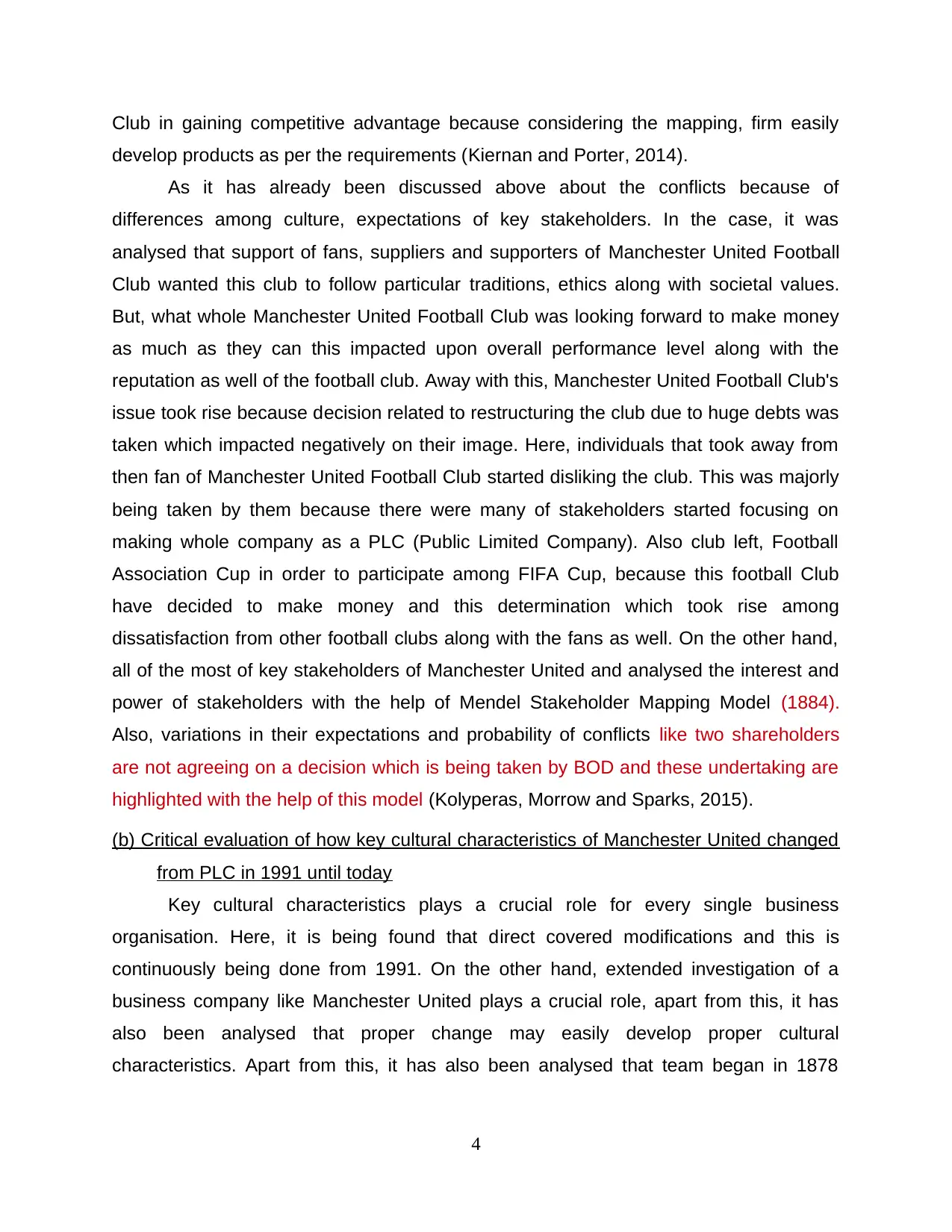
Club in gaining competitive advantage because considering the mapping, firm easily
develop products as per the requirements (Kiernan and Porter, 2014).
As it has already been discussed above about the conflicts because of
differences among culture, expectations of key stakeholders. In the case, it was
analysed that support of fans, suppliers and supporters of Manchester United Football
Club wanted this club to follow particular traditions, ethics along with societal values.
But, what whole Manchester United Football Club was looking forward to make money
as much as they can this impacted upon overall performance level along with the
reputation as well of the football club. Away with this, Manchester United Football Club's
issue took rise because decision related to restructuring the club due to huge debts was
taken which impacted negatively on their image. Here, individuals that took away from
then fan of Manchester United Football Club started disliking the club. This was majorly
being taken by them because there were many of stakeholders started focusing on
making whole company as a PLC (Public Limited Company). Also club left, Football
Association Cup in order to participate among FIFA Cup, because this football Club
have decided to make money and this determination which took rise among
dissatisfaction from other football clubs along with the fans as well. On the other hand,
all of the most of key stakeholders of Manchester United and analysed the interest and
power of stakeholders with the help of Mendel Stakeholder Mapping Model (1884).
Also, variations in their expectations and probability of conflicts like two shareholders
are not agreeing on a decision which is being taken by BOD and these undertaking are
highlighted with the help of this model (Kolyperas, Morrow and Sparks, 2015).
(b) Critical evaluation of how key cultural characteristics of Manchester United changed
from PLC in 1991 until today
Key cultural characteristics plays a crucial role for every single business
organisation. Here, it is being found that direct covered modifications and this is
continuously being done from 1991. On the other hand, extended investigation of a
business company like Manchester United plays a crucial role, apart from this, it has
also been analysed that proper change may easily develop proper cultural
characteristics. Apart from this, it has also been analysed that team began in 1878
4
develop products as per the requirements (Kiernan and Porter, 2014).
As it has already been discussed above about the conflicts because of
differences among culture, expectations of key stakeholders. In the case, it was
analysed that support of fans, suppliers and supporters of Manchester United Football
Club wanted this club to follow particular traditions, ethics along with societal values.
But, what whole Manchester United Football Club was looking forward to make money
as much as they can this impacted upon overall performance level along with the
reputation as well of the football club. Away with this, Manchester United Football Club's
issue took rise because decision related to restructuring the club due to huge debts was
taken which impacted negatively on their image. Here, individuals that took away from
then fan of Manchester United Football Club started disliking the club. This was majorly
being taken by them because there were many of stakeholders started focusing on
making whole company as a PLC (Public Limited Company). Also club left, Football
Association Cup in order to participate among FIFA Cup, because this football Club
have decided to make money and this determination which took rise among
dissatisfaction from other football clubs along with the fans as well. On the other hand,
all of the most of key stakeholders of Manchester United and analysed the interest and
power of stakeholders with the help of Mendel Stakeholder Mapping Model (1884).
Also, variations in their expectations and probability of conflicts like two shareholders
are not agreeing on a decision which is being taken by BOD and these undertaking are
highlighted with the help of this model (Kolyperas, Morrow and Sparks, 2015).
(b) Critical evaluation of how key cultural characteristics of Manchester United changed
from PLC in 1991 until today
Key cultural characteristics plays a crucial role for every single business
organisation. Here, it is being found that direct covered modifications and this is
continuously being done from 1991. On the other hand, extended investigation of a
business company like Manchester United plays a crucial role, apart from this, it has
also been analysed that proper change may easily develop proper cultural
characteristics. Apart from this, it has also been analysed that team began in 1878
4
⊘ This is a preview!⊘
Do you want full access?
Subscribe today to unlock all pages.

Trusted by 1+ million students worldwide
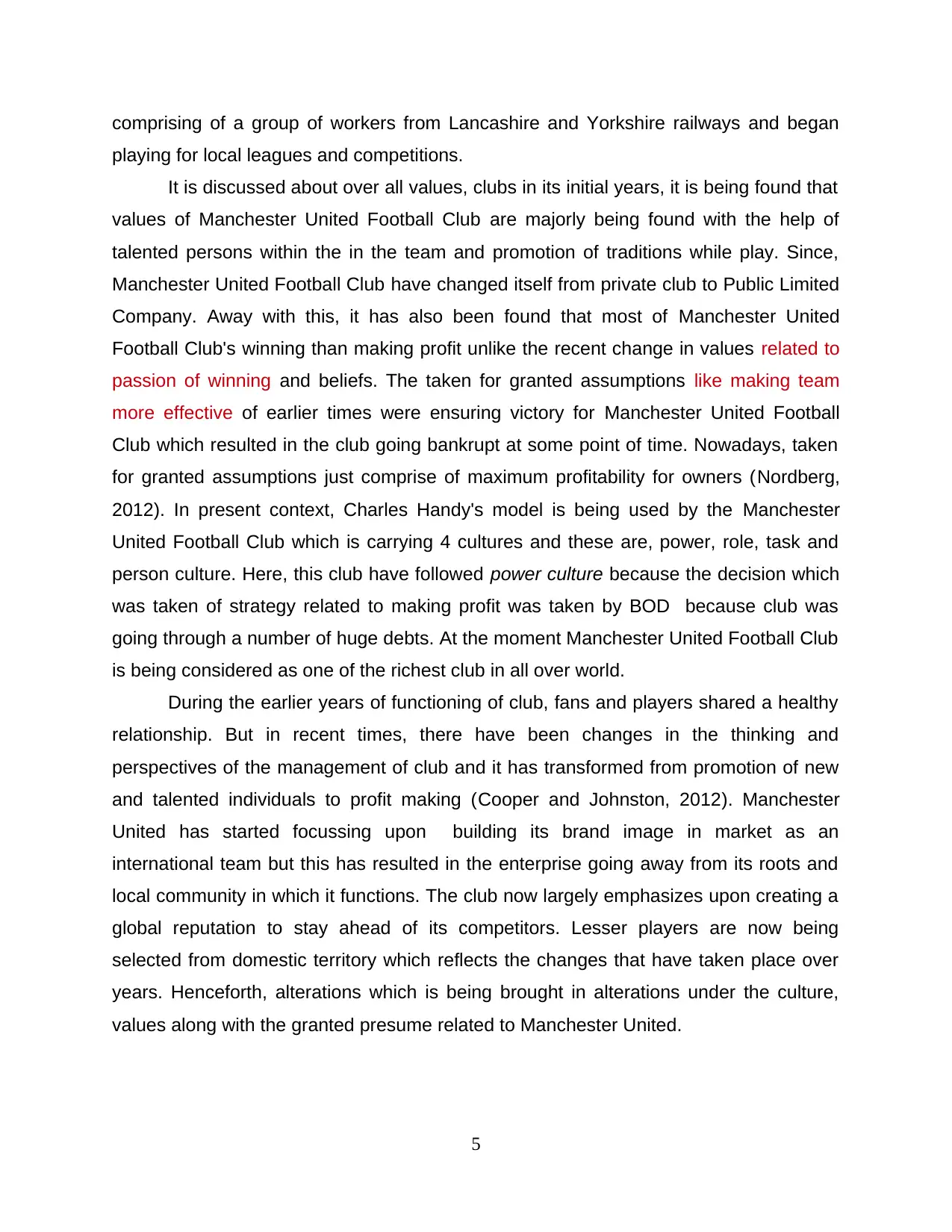
comprising of a group of workers from Lancashire and Yorkshire railways and began
playing for local leagues and competitions.
It is discussed about over all values, clubs in its initial years, it is being found that
values of Manchester United Football Club are majorly being found with the help of
talented persons within the in the team and promotion of traditions while play. Since,
Manchester United Football Club have changed itself from private club to Public Limited
Company. Away with this, it has also been found that most of Manchester United
Football Club's winning than making profit unlike the recent change in values related to
passion of winning and beliefs. The taken for granted assumptions like making team
more effective of earlier times were ensuring victory for Manchester United Football
Club which resulted in the club going bankrupt at some point of time. Nowadays, taken
for granted assumptions just comprise of maximum profitability for owners (Nordberg,
2012). In present context, Charles Handy's model is being used by the Manchester
United Football Club which is carrying 4 cultures and these are, power, role, task and
person culture. Here, this club have followed power culture because the decision which
was taken of strategy related to making profit was taken by BOD because club was
going through a number of huge debts. At the moment Manchester United Football Club
is being considered as one of the richest club in all over world.
During the earlier years of functioning of club, fans and players shared a healthy
relationship. But in recent times, there have been changes in the thinking and
perspectives of the management of club and it has transformed from promotion of new
and talented individuals to profit making (Cooper and Johnston, 2012). Manchester
United has started focussing upon building its brand image in market as an
international team but this has resulted in the enterprise going away from its roots and
local community in which it functions. The club now largely emphasizes upon creating a
global reputation to stay ahead of its competitors. Lesser players are now being
selected from domestic territory which reflects the changes that have taken place over
years. Henceforth, alterations which is being brought in alterations under the culture,
values along with the granted presume related to Manchester United.
5
playing for local leagues and competitions.
It is discussed about over all values, clubs in its initial years, it is being found that
values of Manchester United Football Club are majorly being found with the help of
talented persons within the in the team and promotion of traditions while play. Since,
Manchester United Football Club have changed itself from private club to Public Limited
Company. Away with this, it has also been found that most of Manchester United
Football Club's winning than making profit unlike the recent change in values related to
passion of winning and beliefs. The taken for granted assumptions like making team
more effective of earlier times were ensuring victory for Manchester United Football
Club which resulted in the club going bankrupt at some point of time. Nowadays, taken
for granted assumptions just comprise of maximum profitability for owners (Nordberg,
2012). In present context, Charles Handy's model is being used by the Manchester
United Football Club which is carrying 4 cultures and these are, power, role, task and
person culture. Here, this club have followed power culture because the decision which
was taken of strategy related to making profit was taken by BOD because club was
going through a number of huge debts. At the moment Manchester United Football Club
is being considered as one of the richest club in all over world.
During the earlier years of functioning of club, fans and players shared a healthy
relationship. But in recent times, there have been changes in the thinking and
perspectives of the management of club and it has transformed from promotion of new
and talented individuals to profit making (Cooper and Johnston, 2012). Manchester
United has started focussing upon building its brand image in market as an
international team but this has resulted in the enterprise going away from its roots and
local community in which it functions. The club now largely emphasizes upon creating a
global reputation to stay ahead of its competitors. Lesser players are now being
selected from domestic territory which reflects the changes that have taken place over
years. Henceforth, alterations which is being brought in alterations under the culture,
values along with the granted presume related to Manchester United.
5
Paraphrase This Document
Need a fresh take? Get an instant paraphrase of this document with our AI Paraphraser
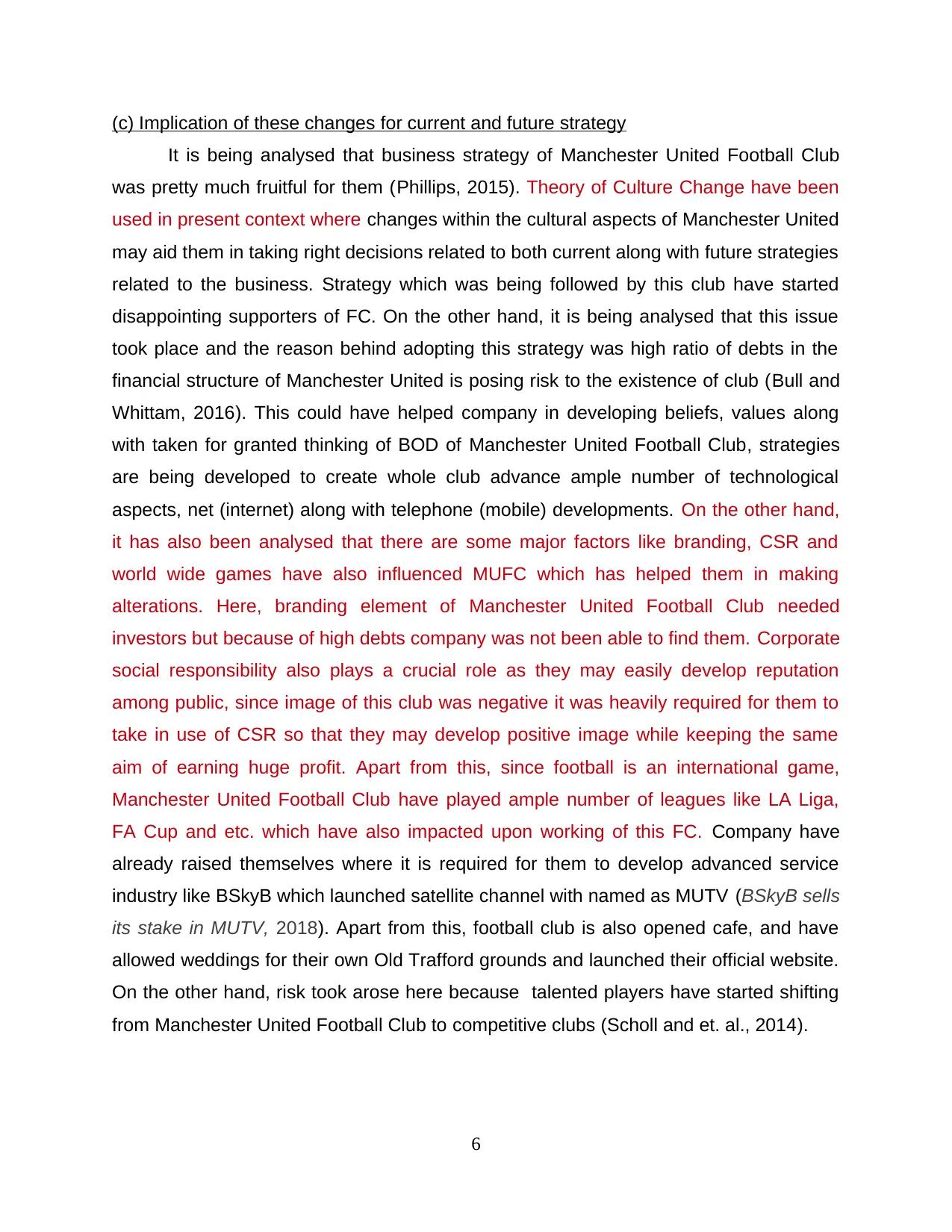
(c) Implication of these changes for current and future strategy
It is being analysed that business strategy of Manchester United Football Club
was pretty much fruitful for them (Phillips, 2015). Theory of Culture Change have been
used in present context where changes within the cultural aspects of Manchester United
may aid them in taking right decisions related to both current along with future strategies
related to the business. Strategy which was being followed by this club have started
disappointing supporters of FC. On the other hand, it is being analysed that this issue
took place and the reason behind adopting this strategy was high ratio of debts in the
financial structure of Manchester United is posing risk to the existence of club (Bull and
Whittam, 2016). This could have helped company in developing beliefs, values along
with taken for granted thinking of BOD of Manchester United Football Club, strategies
are being developed to create whole club advance ample number of technological
aspects, net (internet) along with telephone (mobile) developments. On the other hand,
it has also been analysed that there are some major factors like branding, CSR and
world wide games have also influenced MUFC which has helped them in making
alterations. Here, branding element of Manchester United Football Club needed
investors but because of high debts company was not been able to find them. Corporate
social responsibility also plays a crucial role as they may easily develop reputation
among public, since image of this club was negative it was heavily required for them to
take in use of CSR so that they may develop positive image while keeping the same
aim of earning huge profit. Apart from this, since football is an international game,
Manchester United Football Club have played ample number of leagues like LA Liga,
FA Cup and etc. which have also impacted upon working of this FC. Company have
already raised themselves where it is required for them to develop advanced service
industry like BSkyB which launched satellite channel with named as MUTV (BSkyB sells
its stake in MUTV, 2018). Apart from this, football club is also opened cafe, and have
allowed weddings for their own Old Trafford grounds and launched their official website.
On the other hand, risk took arose here because talented players have started shifting
from Manchester United Football Club to competitive clubs (Scholl and et. al., 2014).
6
It is being analysed that business strategy of Manchester United Football Club
was pretty much fruitful for them (Phillips, 2015). Theory of Culture Change have been
used in present context where changes within the cultural aspects of Manchester United
may aid them in taking right decisions related to both current along with future strategies
related to the business. Strategy which was being followed by this club have started
disappointing supporters of FC. On the other hand, it is being analysed that this issue
took place and the reason behind adopting this strategy was high ratio of debts in the
financial structure of Manchester United is posing risk to the existence of club (Bull and
Whittam, 2016). This could have helped company in developing beliefs, values along
with taken for granted thinking of BOD of Manchester United Football Club, strategies
are being developed to create whole club advance ample number of technological
aspects, net (internet) along with telephone (mobile) developments. On the other hand,
it has also been analysed that there are some major factors like branding, CSR and
world wide games have also influenced MUFC which has helped them in making
alterations. Here, branding element of Manchester United Football Club needed
investors but because of high debts company was not been able to find them. Corporate
social responsibility also plays a crucial role as they may easily develop reputation
among public, since image of this club was negative it was heavily required for them to
take in use of CSR so that they may develop positive image while keeping the same
aim of earning huge profit. Apart from this, since football is an international game,
Manchester United Football Club have played ample number of leagues like LA Liga,
FA Cup and etc. which have also impacted upon working of this FC. Company have
already raised themselves where it is required for them to develop advanced service
industry like BSkyB which launched satellite channel with named as MUTV (BSkyB sells
its stake in MUTV, 2018). Apart from this, football club is also opened cafe, and have
allowed weddings for their own Old Trafford grounds and launched their official website.
On the other hand, risk took arose here because talented players have started shifting
from Manchester United Football Club to competitive clubs (Scholl and et. al., 2014).
6
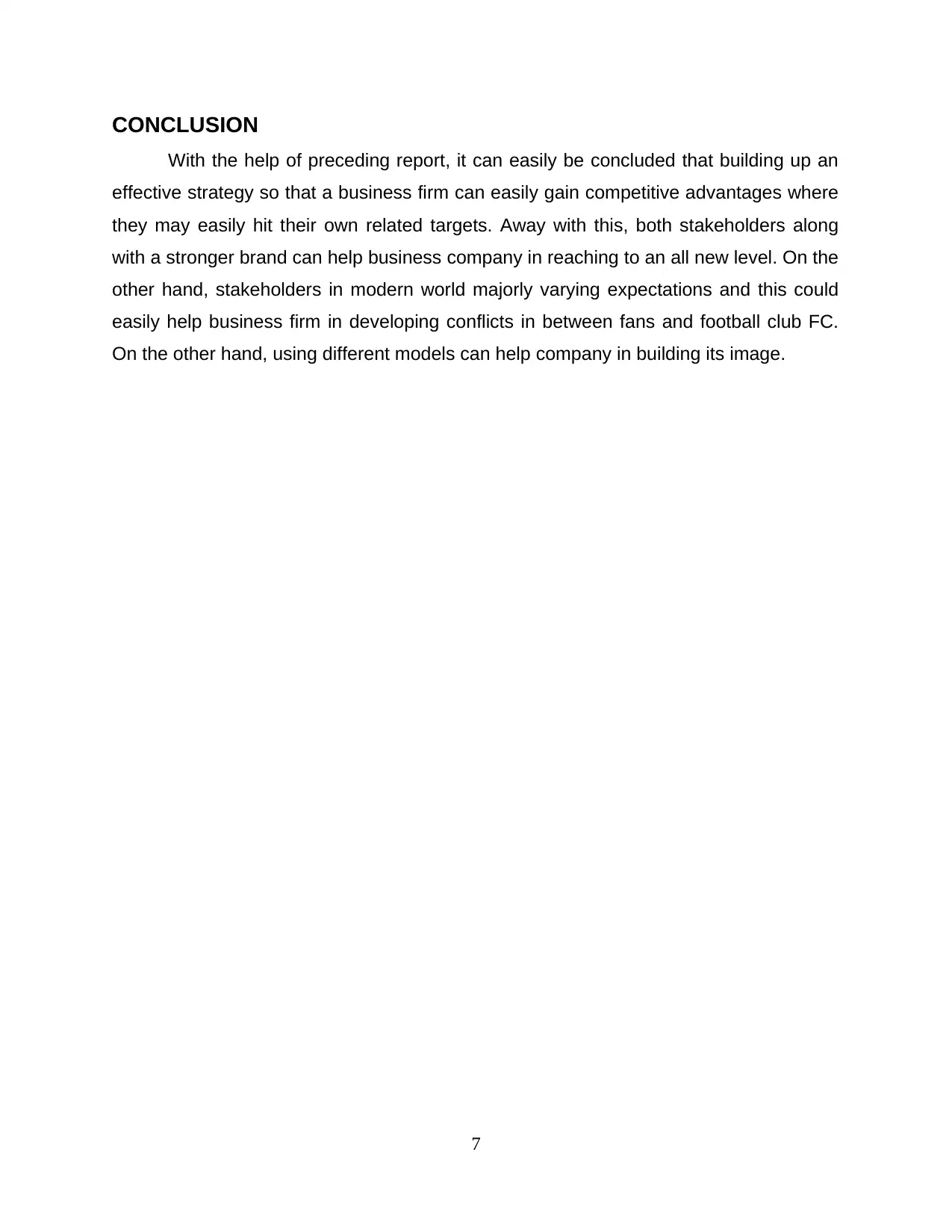
CONCLUSION
With the help of preceding report, it can easily be concluded that building up an
effective strategy so that a business firm can easily gain competitive advantages where
they may easily hit their own related targets. Away with this, both stakeholders along
with a stronger brand can help business company in reaching to an all new level. On the
other hand, stakeholders in modern world majorly varying expectations and this could
easily help business firm in developing conflicts in between fans and football club FC.
On the other hand, using different models can help company in building its image.
7
With the help of preceding report, it can easily be concluded that building up an
effective strategy so that a business firm can easily gain competitive advantages where
they may easily hit their own related targets. Away with this, both stakeholders along
with a stronger brand can help business company in reaching to an all new level. On the
other hand, stakeholders in modern world majorly varying expectations and this could
easily help business firm in developing conflicts in between fans and football club FC.
On the other hand, using different models can help company in building its image.
7
⊘ This is a preview!⊘
Do you want full access?
Subscribe today to unlock all pages.

Trusted by 1+ million students worldwide
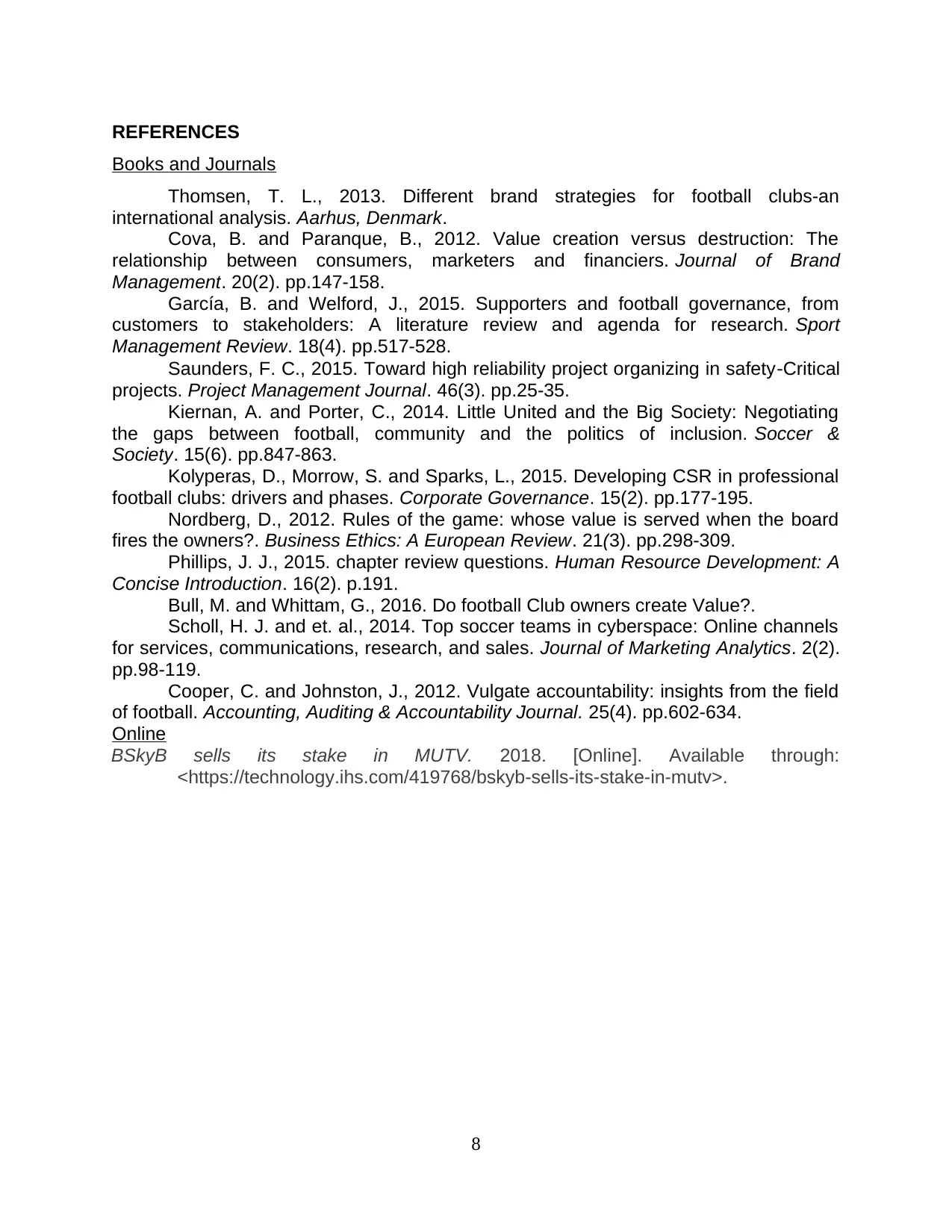
REFERENCES
Books and Journals
Thomsen, T. L., 2013. Different brand strategies for football clubs-an
international analysis. Aarhus, Denmark.
Cova, B. and Paranque, B., 2012. Value creation versus destruction: The
relationship between consumers, marketers and financiers. Journal of Brand
Management. 20(2). pp.147-158.
García, B. and Welford, J., 2015. Supporters and football governance, from
customers to stakeholders: A literature review and agenda for research. Sport
Management Review. 18(4). pp.517-528.
Saunders, F. C., 2015. Toward high reliability project organizing in safety‐Critical
projects. Project Management Journal. 46(3). pp.25-35.
Kiernan, A. and Porter, C., 2014. Little United and the Big Society: Negotiating
the gaps between football, community and the politics of inclusion. Soccer &
Society. 15(6). pp.847-863.
Kolyperas, D., Morrow, S. and Sparks, L., 2015. Developing CSR in professional
football clubs: drivers and phases. Corporate Governance. 15(2). pp.177-195.
Nordberg, D., 2012. Rules of the game: whose value is served when the board
fires the owners?. Business Ethics: A European Review. 21(3). pp.298-309.
Phillips, J. J., 2015. chapter review questions. Human Resource Development: A
Concise Introduction. 16(2). p.191.
Bull, M. and Whittam, G., 2016. Do football Club owners create Value?.
Scholl, H. J. and et. al., 2014. Top soccer teams in cyberspace: Online channels
for services, communications, research, and sales. Journal of Marketing Analytics. 2(2).
pp.98-119.
Cooper, C. and Johnston, J., 2012. Vulgate accountability: insights from the field
of football. Accounting, Auditing & Accountability Journal. 25(4). pp.602-634.
Online
BSkyB sells its stake in MUTV. 2018. [Online]. Available through:
<https://technology.ihs.com/419768/bskyb-sells-its-stake-in-mutv>.
8
Books and Journals
Thomsen, T. L., 2013. Different brand strategies for football clubs-an
international analysis. Aarhus, Denmark.
Cova, B. and Paranque, B., 2012. Value creation versus destruction: The
relationship between consumers, marketers and financiers. Journal of Brand
Management. 20(2). pp.147-158.
García, B. and Welford, J., 2015. Supporters and football governance, from
customers to stakeholders: A literature review and agenda for research. Sport
Management Review. 18(4). pp.517-528.
Saunders, F. C., 2015. Toward high reliability project organizing in safety‐Critical
projects. Project Management Journal. 46(3). pp.25-35.
Kiernan, A. and Porter, C., 2014. Little United and the Big Society: Negotiating
the gaps between football, community and the politics of inclusion. Soccer &
Society. 15(6). pp.847-863.
Kolyperas, D., Morrow, S. and Sparks, L., 2015. Developing CSR in professional
football clubs: drivers and phases. Corporate Governance. 15(2). pp.177-195.
Nordberg, D., 2012. Rules of the game: whose value is served when the board
fires the owners?. Business Ethics: A European Review. 21(3). pp.298-309.
Phillips, J. J., 2015. chapter review questions. Human Resource Development: A
Concise Introduction. 16(2). p.191.
Bull, M. and Whittam, G., 2016. Do football Club owners create Value?.
Scholl, H. J. and et. al., 2014. Top soccer teams in cyberspace: Online channels
for services, communications, research, and sales. Journal of Marketing Analytics. 2(2).
pp.98-119.
Cooper, C. and Johnston, J., 2012. Vulgate accountability: insights from the field
of football. Accounting, Auditing & Accountability Journal. 25(4). pp.602-634.
Online
BSkyB sells its stake in MUTV. 2018. [Online]. Available through:
<https://technology.ihs.com/419768/bskyb-sells-its-stake-in-mutv>.
8
1 out of 10
Your All-in-One AI-Powered Toolkit for Academic Success.
+13062052269
info@desklib.com
Available 24*7 on WhatsApp / Email
![[object Object]](/_next/static/media/star-bottom.7253800d.svg)
Unlock your academic potential
Copyright © 2020–2025 A2Z Services. All Rights Reserved. Developed and managed by ZUCOL.


